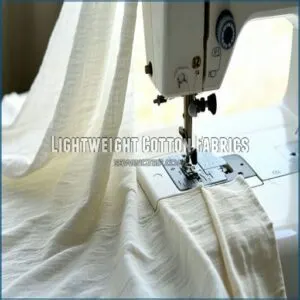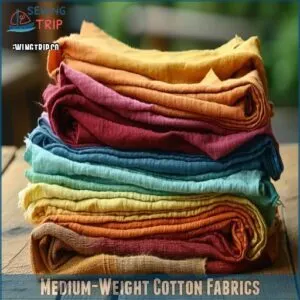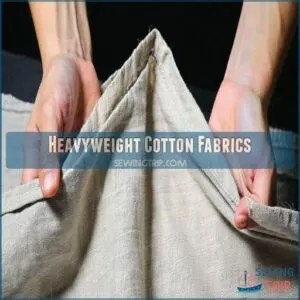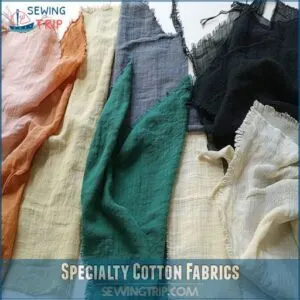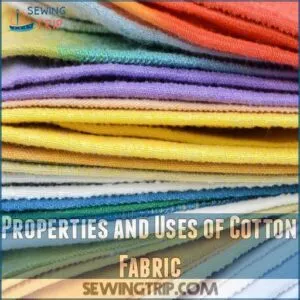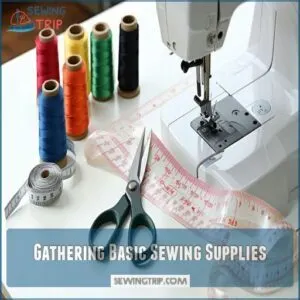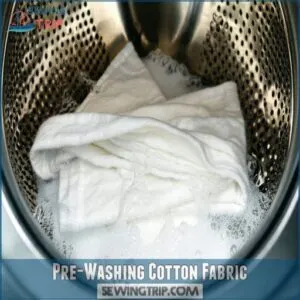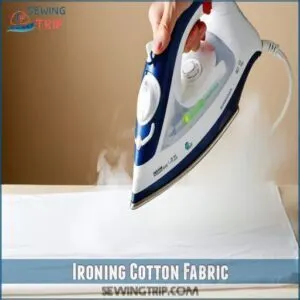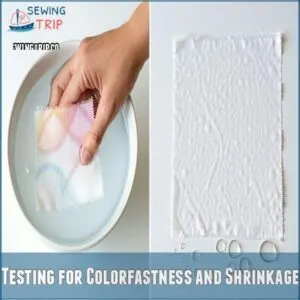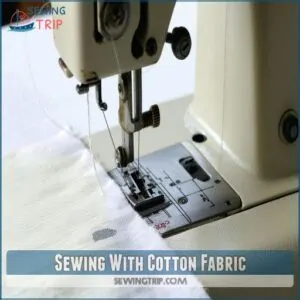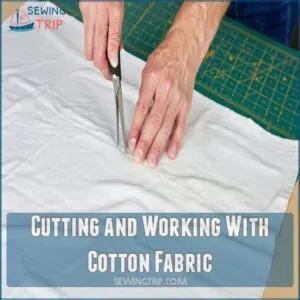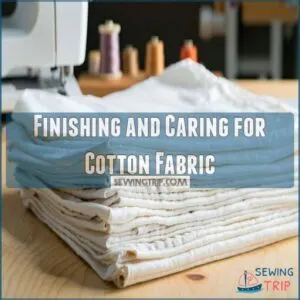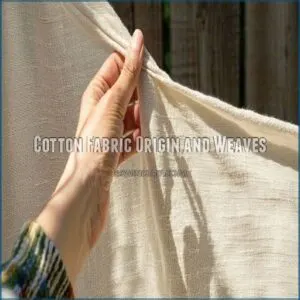This site is supported by our readers. We may earn a commission, at no cost to you, if you purchase through links.

They’re all uniquely charming, like different pets with distinct personalities.
Prep first: gather tools, pre-wash, and iron, because nobody loves unplanned shrinkage!
Set your sewing machine to the right needle and stitch it up, then finish seams with zig-zag for durability.
Remember: cutting fabric is the art here—pin it well and cut where it matters.
If all goes well, you’ll be a fabric whisperer in no time.
Get started with this guide and discover those sneaky tips to elevate your sewing game to new heights!
Table Of Contents
Key Takeaways
- You’ll need to know your cotton fabrics—light, medium, and heavyweight—each serving different purposes from airy summer wear to durable tote bags.
- Before sewing, pre-wash your fabric to prevent shrinkage and set your sewing machine correctly with the right needle size and stitch length.
- Master cutting techniques by carefully pinning and aligning pattern pieces, ensuring precise cuts and a professional finish.
- Embrace finishing touches like serging or zig-zag stitching to add durability and prevent fraying, keeping your cotton creations looking polished and lasting longer.
Types of Cotton Fabric
When you’re sewing with cotton, understanding the types of fabric is essential, like knowing your cake from your frosting.
From the lightweight voile that breezes through summer to the sturdy denim that stands strong in winter, each offers a unique feel and purpose.
Lightweight Cotton Fabrics
Imagine sewing a summer dress that feels like a gentle breeze.
With lightweight cotton fabrics like lawn, voile, and muslin, you’re crafting airy fashion that’s perfect for hot days.
These materials are your best bet for creating breathable clothing, making them ideal for DIY projects where comfort meets style.
Get started with summer sewing tips, and let your creativity flow effortlessly!
Medium-Weight Cotton Fabrics
Medium-weight cotton fabrics, like chambray and gingham, are your go-to for versatile sewing projects.
Perfect for quilting and everyday wear, they balance durability with a comfy feel.
These fabrics shine in popular patterns and fabric blends, making them easy to care for.
Just toss them in the wash, and they’re ready for your next creation!
Heavyweight Cotton Fabrics
Heavyweight cotton fabrics, like denim and canvas, bring durability to your sewing projects.
Imagine sturdy jeans or a durable tote—these fabrics hold up through thick and thin.
Their rugged nature means less wear and tear, perfect for items that need extra strength.
When choosing the right fabric, always consider the fabric weight and properties for your specific design needs.
Specialty Cotton Fabrics
Several unique cotton fabrics deserve a closer look.
These specialty cotton fabrics offer exciting possibilities for your projects.
- Aertex: Lightweight and breathable, perfect for summer shirts.
- Brocade: Adds a touch of elegance with woven designs.
- Candlewick: Ideal for embroidery, creating textured designs.
- Chenille: Super soft, great for cozy blankets and plush toys.
These cotton fabric blends and specialty cotton fabrics open up a world of creative choices.
Explore these unique textures!
Properties and Uses of Cotton Fabric
Cotton fabric is like the trusty sidekick you’ve always wanted—versatile, durable, and ready for anything from your cozy pajamas to that waterproof jacket.
Cotton is a versatile fabric.
Whether you’re crafting breezy summer blouses or sturdy denim jeans, understanding cotton’s unique properties makes sure that each creation serves both style and function perfectly.
Thin Fabrics
For thin fabrics, think of them as your best friend for summer sewing projects.
Their sheerness and drape make them ideal for anything light and airy.
In other words, they’re the cotton fabric types that keep you cool and stylish.
Just remember, a gentle touch is needed for care to extend their life.
| Fabric Type | Weight | Best Use |
|---|---|---|
| Batiste | Lightweight | Dresses |
| Voile | Lightweight | Blouses |
| Lawn | Lightweight | Tops |
| Muslin | Medium-weight | Linings |
| Gauze | Lightweight | Scarves |
Lustrous Fabrics
Think of lustrous fabrics like the finale of a fireworks show—eye-catching and full of sparkle!
Use sateen and silk blends to add that extra shine to your creations.
They’re your go-to for projects needing a touch of glam.
Remember, a good shine isn’t just fancy; it’s about mastering those finishing techniques to enhance the fabric’s natural sheen.
Raised Surface Texture
After exploring lustrous fabrics, let’s shift gears to textures with character.
Fabrics like Bedford cord, pique, and corduroy add depth to your projects.
Feel the ridges of corduroy – they’re like the cool kid of fabric, adding dimension to pants and jackets.
Flannel offers that soft, cozy vibe for quilts, while velveteen gives a plush, luxurious touch.
Stretch Fabrics
Stretch fabrics offer flexibility with spandex blends and jersey knits, perfect for that comfy activewear you love.
Embrace the freedom of movement these cotton knit fabrics give you, especially when you’re sewing.
Remember, using the right sewing techniques can prevent those pesky puckers.
So, don’t hold back—dance like nobody’s watching in your stretch cotton creations!
Durable Fabrics
Durable fabrics keep your creations standing tall for the long haul.
Denim and twill lead the pack when you’re seeking strength.
To make the most of cotton blend strength, check out these tips:
- Test your fabric’s durability by giving it a tug.
- Embrace heavy-duty stitches.
- Avoid overloading your washing machine.
- Reinforce high-stress areas with extra stitching.
Waterproof Cotton
So, you’ve mastered durable cottons?
Let’s move on to waxed cotton!
This isn’t your grandma’s tablecloth; waxed cotton, with its special coating, becomes a superhero fabric for outdoor projects.
Think tents, bags – anything needing a bit of water resistance.
It’s all about the right waterproofing methods for your sewing projects, and cotton care is a breeze afterward.
Preparing Cotton Fabric for Sewing
Preparing cotton fabric for sewing is like making sure your shoes are tied before a big race—you don’t want to trip at the first stitch!
Pre-shrinking and testing for color bleeding are essential steps.
Start by gathering your sewing supplies, giving the fabric a good wash to pre-shrink it, and testing that vibrant color for any sneaky bleeding before you begin.
Gathering Basic Sewing Supplies
Before diving into your sewing adventure, gather these essentials and avoid those frustrating mid-project "Oh no" moments.
Stock up on:
- Fabric scissors: essential for crisp, clean cuts.
- Measuring tape: guarantees accuracy.
- Thread varieties: match different fabric types.
- Sewing machine types: choose one that fits your projects.
- Pins and needles: critical for precision.
You’re armed and ready to create!
Pre-Washing Cotton Fabric
Don’t skip pre-washing your cotton fabric.
It’s like giving it a little spa day to avoid surprises like shrinkage or color bleeding when you start sewing.
Toss it in a cold water wash and let it dry naturally.
This simple step guarantees your beautiful cotton fabric behaves itself later on in your project, making fabric care a breeze!
Ironing Cotton Fabric
Wrinkle removal might sound mundane, but it’s the secret sauce to transforming unruly cotton fabric into a sewing masterpiece.
Wrinkle removal is like giving your fabric a spa day before it hits the sewing machine.
Select the right ironing temperature, and don’t skimp on steam.
Use your trusty ironing board to smooth out even the toughest creases.
Testing for Colorfastness and Shrinkage
Ironing done? Let’s chat about testing for colorfastness and shrinkage. You don’t want unexpected surprises!
For color bleeding, soak a fabric swatch in cold water and gently rub. Any dye transfer spells trouble.
For fabric shrinkage, wash a sample in warm water, then steam it with a hot iron.
These tests keep your cotton sewing projects under control!
Sewing With Cotton Fabric
Sewing with cotton fabric isn’t as tricky as threading a needle in the dark, but it does require some know-how to avoid those sewing mishaps.
You’ll want to pick the right seam type and needle size, adjust your stitch length, and finish with sergers or a zig-zag stitch for tidy seams.
Choosing Seam Types and Needle Size
Let’s get those seams sewn! Choosing the right seam type and needle size for your sewing cotton project is key.
French seam is elegant for lightweight cotton fabric.
Heavier cotton fabric? A sturdy seam allowance is your friend.
Match your needle type to your fabric weight—small needles for fine fabrics, larger ones for denim.
Remember, the right tools make all the difference!
Selecting Stitch Length and Machine Settings
Stitch length can make or break your cotton sewing project!
When you’re choosing settings on your sewing machine, consider these tips:
- Match stitch length to fabric weight.
- Choose needle sizes wisely for clean seams.
- Tension control is key to avoid puckers.
- Test stitches on scrap fabric to get a feel.
Master these, and your creations will shine!
Grading Seams for Bulk Reduction
Reducing bulk in seams is like trimming the fat off a juicy steak—it makes a difference.
Grading your seams by trimming each layer at varying widths creates a comfortable, smooth feel in your cotton fabric creations.
Think of it as giving each seam a custom fit, enhancing your sewing mastery.
Finishing Seams With Sergers or Zig-Zag Stitch
You’ll need a solid seam finish, and that’s where sergers and zig-zag stitches come in. Each has its perks: for a seamless serger seam finish, you can find related products at serger seam finish tools.
- Serger vs. Zig-Zag: Both add durability.
- Overlock Stitches: Create neat edges.
- Seam Appearance: Professional look.
- Finishing Techniques: Prevent fraying.
- Seam Finishes: Enhance garment life.
Love your process like a chef perfects a dish!
Cutting and Working With Cotton Fabric
When you’re cutting and working with cotton fabric, a little planning goes a long way, so don’t rush this step!
Make sure you’ve got your pattern pieces laid out perfectly, your pins at the ready, and remember—measure twice, cut once to avoid any oops moments!
Laying Out Pattern Pieces
You’ve chosen your needle; now, let’s align those patterns like a pro.
Imagine fabric’s threads as a highway—your grain line‘s the main lane, keeping traffic smooth.
Folding your fabric? It’s like making a perfect sandwich.
Understanding the fabric’s grain direction and proper aligning grainline with fabric grain can really impact a garment’s drape, elasticity, and overall appearance.
Here’s a handy chart:
| Step | Action | Purpose |
|---|---|---|
| 1 | Check grain line | Avoid twists |
| 2 | Align pattern | Precise fit |
| 3 | Fold fabric | Double efficiency |
| 4 | Mark with care | Clear roadmap |
Happy sewing!
Pinning and Cutting Fabric
Diving into the fabric cutting process can feel like stepping into a culinary adventure, where precision knives and marinated meats swap for cutting tools and layers of fabric. Trust me, embrace it:
- Make sure proper fabric grain alignment is maintained.
- Use sharp cutting tools.
- Secure patterns with precise pinning techniques.
- Work on flat surfaces.
- Maintain consistent fabric layers.
Basting and Marking Fabric
Let’s get those pattern pieces perfectly placed! Basting, a temporary stitch, holds everything in place before the final sewing. Marking your fabric guarantees accurate seam allowances and pattern placement.
Here’s a handy guide:
| Basting Technique | Marking Tool | Fabric Grain | Seam Allowances |
|---|---|---|---|
| Hand basting | Tailor’s chalk | Straight of grain | 5/8 inch |
| Machine basting | Tracing wheel | Crosswise grain | 1/2 inch |
| Long basting stitch | Marking pens | Bias | 3/8 inch |
Following these steps helps you sew with confidence, resulting in professional-looking cotton creations.
Using Appropriate Pins and Tailor’s Chalk
After the basting comes precision, and that’s where knowing your pin types and chalk colors matters.
Choose glass-head pins for heat-safe sewing, while plastic ones might melt on you.
Tailor’s chalk in contrasting shades makes visibility a breeze. Think of it like choosing a highlighter for your cotton fabric guide.
Mastering these techniques gives your sewing the edge!
Finishing and Caring for Cotton Fabric
Taking care of your cotton creations involves more than just tossing them in the wash; it’s about showing some love so they’ll last.
Whether you’re ironing out wrinkles or adding a touch of embroidery flair, this guide’s got you covered with easy tips to keep your fabric looking fabulous.
Washing and Drying Cotton Fabric
When handling cotton fabric, washing at the right temperature is key to avoiding shrinkage.
Warm water is the best choice unless you’ve got stains, then hotter’s better.
Remember, some colors might bleed, so go easy on the white socks!
In the dryer, low to medium settings work best to keep your fabric from waving the shrink flag.
Ironing and Steaming Cotton Fabric
Great, your freshly washed cotton fabric is ready to meet its iron. For the best ironing results, consider investing in a high-quality cotton iron.
Here’s how to banish those wrinkles like a pro:
- Ironing Temperature: Set to medium-hot; test first on a scrap.
- Steam Settings: Use steam for stubborn wrinkles.
Always check the iron settings before starting and adjust as needed with the right cotton iron tools.
Fabric Types: Check labels for specific care.
Ironing Tips: Press, don’t drag, to keep fabric shape.
Embellishing Cotton Fabric With Embroidery
Embroidery on cotton fabric can transform your creations from simple to stunning.
Choose vibrant thread colors and interesting design ideas to keep it fresh.
Don’t forget to select the right needle size!
Proper fabric prep guarantees smooth sewing, and for this, it’s important to use thread management techniques.
Keep your stitches consistent; they’re the key to dazzling cotton fabric projects.
Ready to start embroidering? Let’s get started!
| Stitch Type | Thread Color | Needle Size |
|---|---|---|
| Backstitch | Red | 9 |
| Cross-Stitch | Blue | 8 |
| Chain Stitch | Green | 7 |
| Satin Stitch | Yellow | 10 |
| Running | Black | 6 |
Cotton Fabric Origin and Weaves
When you’re working with cotton fabrics, it’s important to know where your material comes from and how it’s woven to get the most out of your sewing projects.
Understanding the variety in plant types and weaves, like Egyptian cotton’s smooth fibers or twill’s durability, can help you choose the perfect fabric for any creation.
Types of Cotton Plants
Now that you’ve mastered caring for your cotton creations, let’s talk about where it all begins: the cotton plant itself!
Did you know there’s more than one type? You’ve got your everyday cotton, but then there’s Egyptian cotton, famous for its extra-long fibers, making it super soft. Pima cotton‘s another star, prized for its strength and luxurious feel.
Each variety has its own quirks, influencing the final fabric.
These cotton plant varieties need specific growing conditions—sunshine, water, and warmth—to thrive. Understanding these differences helps you choose the perfect fabric for your next project.
Understanding Fabric Weave
Fabric weaves give cotton its unique characteristics, like a plain weave’s simplicity, twill weave’s diagonal charm, or satin weave’s smooth elegance.
To find the perfect cotton fabric for your project, consider exploring different cotton fabric types, which can be found on various online marketplaces such as cotton fabric types.
Understanding these structures is key in sewing:
- Plain Weave: Over-under pattern, straightforward and versatile.
- Twill Weave: Diagonal lines add strength and style.
- Satin Weave: Smooth, shiny surface perfect for luxe creations.
Guide to Different Types of Cotton Fabric
Think of cotton as your trusty Swiss army knife in the fabric world.
Whether it’s the sturdy twill of denim or the cozy warmth of flannel, each type brings something unique to your sewing projects.
Understanding the different types of cotton weave patterns can help you choose the right fabric for your needs, whether you’re looking for a crisp and breathable percale or a luxurious and smooth sateen.
Cotton blends add flexibility, making fabric care a breeze.
Understanding these fabrics helps you elevate your creations, adding warmth and durability with ease.
Frequently Asked Questions (FAQs)
How do you sew cotton fabric?
Sewing cotton is a breeze!
Pre-wash to prevent shrinkage.
Then select a universal needle and cotton thread.
Pin your pattern precisely.
Adjust your machine for seamless stitching, finishing with a zig-zag or serger stitch for durability.
Is cotton easy to sew?
Cotton’s a dream to sew!
It’s forgiving, easy to handle, and readily available.
You’ll find it a breeze, even as a beginner.
Just grab your needles and thread; let’s get stitching!
What fabrics are used in sewing?
In sewing, you can use a variety of fabrics like cotton, linen, silk, wool, and synthetics like polyester and nylon.
Fabrics suit different projects, providing unique textures, durability, and ease of handling.
What are the different types of cotton fabric?
Think all cotton’s the same? It’s not!
Explore lightweight options like voile or batiste, sturdy types like denim, and specialty fabrics like Pima cotton.
Each serves unique purposes, offering a range of textures and applications for every need.
What thread should I use to sew a cotton knit?
Use a polyester or all-purpose thread with a ballpoint needle for sewing cotton knit.
This combination prevents snags, ensuring smoother seams.
Trying to sew stretch fabric with regular thread? You’re asking for trouble!
Which fabric should a beginner sew?
Start with cotton muslin for your first sewing project.
It’s affordable, easy to handle, and forgiving of mistakes.
Its lightweight nature makes it a favorite for practicing stitches and gaining confidence in your sewing skills.
What is the sewing setting for cotton?
Set your sewing machine with a universal needle and a stitch length of 5-0 mm for cotton fabric.
Adjust tension to avoid puckering.
Test on a scrap first.
Don’t fret—practice makes perfect!
What needle do you use for cotton fabric?
While delicate voile whispers elegance, a universal needle (size 80/12) tackles most cotton tasks effortlessly.
For tougher characters like denim, switch to a heavyweight needle (size 90/14 or denim-specific), ensuring your stitches sing in harmony.
What is the best cotton fabric to sew with?
The best cotton fabric depends on your project! Lightweight cotton’s great for breezy summer shirts, while sturdy denim makes durable jeans. Choose wisely, and happy sewing!
Can you sew clothes with 100% cotton?
Absolutely, you can sew clothes with 100% cotton.
It’s breathable, durable, and easy to handle—like a trusty friend in your sewing toolkit.
Whether you’re crafting shirts, dresses, or pants, cotton’s got your back.
How do I choose sustainable cotton fabric?
When choosing sustainable cotton, look for organic options certified by labels like GOTS or Fair Trade.
Prioritize recycled cotton if available and support brands with transparent, ethical practices.
These choices reduce environmental impact and enhance durability.
What are budget-friendly cotton fabric options?
Imagine a treasure trove of cotton options like muslin, chambray, and gingham.
They’re affordable, versatile, and perfect for any project.
You’ll find them in local stores, offering you creativity without breaking the bank!
How does cotton fabric impact the environment?
Cotton fabric impacts the environment by using large amounts of water for cultivation and often involves pesticides, which can harm ecosystems.
Organic cotton helps reduce these effects, promoting a more sustainable planet.
How to prevent cotton fabric from pilling?
To prevent cotton from pilling, wash it inside out on a gentle cycle and avoid high heat in the dryer.
Use a fabric softener and skip the rough surfaces when wearing or storing cotton garments.
What are alternatives to cotton fabric?
Think cotton’s the only game in town?
Consider linen for summer coolness, silk for luxe vibes, or hemp for eco-friendly vibes.
Each offers unique textures and benefits, keeping your projects fresh and full of personality.
Conclusion
So, there you have it—your detailed cotton fabric sewing guide! You’ve learned about different cotton types, prepping techniques, and sewing secrets.
Remember those perfectly pressed seams?
Now you’re ready to tackle any cotton project. From lightweight blouses to durable tote bags, your newfound skills will shine. This cotton fabric sewing guide empowers you to create beautiful, long-lasting pieces. Happy sewing!

